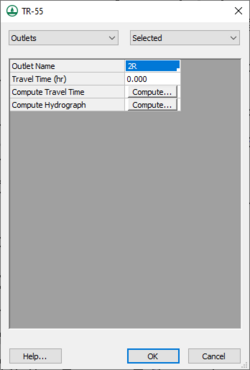WMS:TR-55 Outlet Data: Difference between revisions
(→Name) |
(→Name) |
||
| Line 5: | Line 5: | ||
==Name== | ==Name== | ||
The | The ''Outlet Name'' is used to identify individual outlets within a larger watershed. As with all outlets created in WMS, the name is defaulted to “ID”R where ID is an internal identification number and R stands for outlet. The name can be changed to something more identifiable at any time. While TR-55 does not require that outlet names are unique, other models supported by WMS do. | ||
==Related Topics== | ==Related Topics== | ||
Revision as of 23:24, 12 December 2017
WMS allows defining the watershed as a single basin or subdivide the watershed into multiple sub-basins. Besides computing peak flows using the standard TR-55 equations, storm hydrographs may also be computed for each basin and then combined/lagged to downstream outlets (junctions) using the TR-55 tabular hydrograph method.
When creating a watershed with multiple sub-basins, define the time of travel from one outlet (junction) to the next. The travel time for an outlet is defined by selecting the outlet and then entering the appropriate travel time. If desired, use a time computation arc to compute the travel time.
Name
The Outlet Name is used to identify individual outlets within a larger watershed. As with all outlets created in WMS, the name is defaulted to “ID”R where ID is an internal identification number and R stands for outlet. The name can be changed to something more identifiable at any time. While TR-55 does not require that outlet names are unique, other models supported by WMS do.
Related Topics
WMS – Watershed Modeling System | ||
|---|---|---|
| Modules: | Terrain Data • Drainage • Map • Hydrologic Modeling • River • GIS • 2D Grid • 2D Scatter |  |
| Models: | CE-QUAL-W2 • GSSHA • HEC-1 • HEC-HMS • HEC-RAS • HSPF • MODRAT • NSS • OC Hydrograph • OC Rational • Rational • River Tools • Storm Drain • SMPDBK • SWMM • TR-20 • TR-55 | |
| Toolbars: | Modules • Macros • Units • Digitize • Static Tools • Dynamic Tools • Drawing • Get Data Tools | |
| Aquaveo | ||
